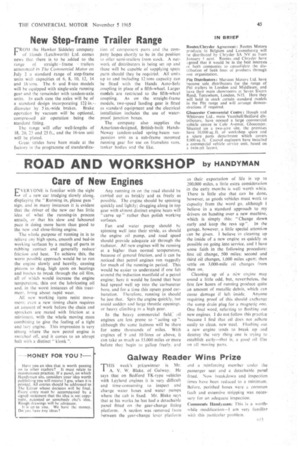ROAD AND WORKSHOP by HANDYMAN
Page 47

If you've noticed an error in this article please click here to report it so we can fix it.
Care of New Engines
EVERYONE is familiar with the sight of a new car trudging slowly along, displaying the "Running in, please pass" sign, and in many instances it is evident that the driver of the new car has little idea of what the running-in process entails, or that his slow and laboured pace is doing more harm than good to the new and close-fitting engine.
The whole purpose of running in is to relieve any high spots, smooth and bed-in working surfaces by a mating of parts in rubbing contact and generally . reduce' friction and heat. To achieve this, the worst possible approach would be to run the engine slowly and heavily, causing pistons to drag, high spots on bearings and bushes to break through the oil film, all of which would increase the engine temperature, thin out the lubricating oil and, in the worst instances of this treatment. bring about rapid wear.
All new working items resist movement; even a new timing chain requires an amount of work before the chain and sprockets are mated with friction at a minimum, with the whole moving mass combining to give the feeling of a tight and lazy engine. This impression is very strong where the new petrol engine is switched off, and it comes to an abrupt halt with a distinct klonk ". Any running in on the road should •be carried out as briskly and as freely as possible. The engine should be spinning quickIV and lightly; dragging along in top gear with almost distinct engine heats will " carve up" rather than polish working surf aces.
Fan and water pump should be spinning well into their stride, as should the engine oil pump, and road speed should provide adequate air through the radiator. All new engines will be running at a higher than normal temperature, because of general friction, and it can be noticed that petrol engines run raggedly for much of the running-in period. This would be easier to understand if one felt around the induction manifold of a petrol engine; here it would be found that heat had spread well up into the 'carburetter bore, and for a time this upsets good carburation. Therefore, running in should he just that. Spin the engine quickly, but avoid sudden and large throttle openings. or heavy climbing in a high gear.
In the heavy commercial field: nil engines are less prone to "acting up ". although the same laziness will be there for some thousands of miles. With engines of 9 and 10 litres or above, it can take as much as 15.000 miles or more before they begin to gallop freely. and as their expectation of life is up to 200,000 miles, a tittle extra consideration in the early months is well worth while. There is little else that can be done, however, as goods vehicles must work to capacity from the word go, although I believe in a standard approach to my drivers on handing over a new machine, which is simply this: "Change down early and keep the revs up ". In the garage, however, a little special attention can be given. I believe in cleaning up the inside of a new engine as quickly as possible on going into service, and I have some faith in the following procedure; first oil change, 500 miles; second and third oil changes, 1,000 miles apart; then settle on 3,000-mile oil changes from then on.
Cleaning up of a ntEw engine may sound a little odd, but, nevertheless, the first few hours of running produce quite an amount of metallic debris, which can
cause damage if left inside. Anyone requiring proof of this should exchange the sump drain plug for a magnetic one. One final word, referring to flushing out new engines. I do not follow this practice because I find that oil does not adhere easily to clean, new steel. Flushins out a new engine tends to break up and destroy the very thing one is trying to establish early—that is, a good oil film on all moving parts.




















































































































